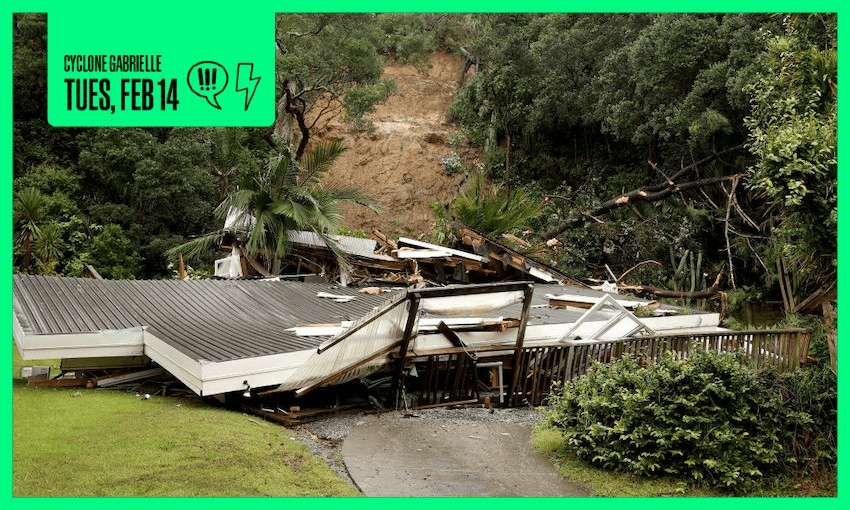‘I can’t imagine that they’ll let us go back and live there’, says a stunned homeowner forced to flee twice during a night of utter chaos.
Caroline Bell-Booth is, for the moment, safe. “All our houses are shaking constantly,” she says. “You leap out of your skin every time there’s a clang or a bash because you think something’s about to fly off the houses.”
As Bell-Booth talks, Cyclone Gabrielle continues to batter Muriwai, one of the worst hit regions in a storm that’s caused devastation from Gisborne to Whangārei. “It’s irrepressible,” she says. “It’s still going on now … it’s so gnarly out here at the moment. It’s too dangerous to move … we’ve just got to get through tonight.”
Shellshocked is how Bell-Booth describes her mood after the past 24 hours. She, along with her husband, their two dogs and their cat, were forced to flee two homes overnight as they tried to escape the wrath of the cyclone’s path.
Slips have flattened homes in the West Auckland beachside community, and there’s more slips and widespread flooding in the nearby suburb of Piha. “A hot mess” is how Bell-Booth describes the place she’s called home for the past eight years. “All the rain has just been colossal. Down the end of our road … trees have gone through people’s homes. Houses are completely destroyed. Like, utterly pancaked. It’s vicious.”
It’s not just property that’s been affected. Late last night, Muriwai’s volunteer firefighting crew attended a callout to Motutara Road when a slip occurred, leaving one firefighter missing and another in a critical condition. “They’re total heroes for what they were doing for everybody else,” says Bell-Booth, who says the volunteers are, like everyone who lives in the tight-knit community, close friends.
She’d seen them earlier in the night after texting one of them, asking for help with her own home on Domain Crescent. The TV director was hunkering down with her husband Matt Hodgson when the cyclone rolled in. They’d gotten prepared, listening to advice and packing emergency bags for them, their dogs Ted and Lottie, and their cat in case they had to evacuate.
Around 8pm, a slip came down behind their house, forcing a tree to lean on the side of their home. “I just let my mate know who’s in the fire brigade … so the boys came up immediately,” she says. “They chopped the tree down that was pressing against our window.”
Around the same time, the cliffs behind their home and many others along their street began to creak. “it was just so frightening, because you couldn’t see but you could just hear things cracking,” she says. “My husband and the volunteers were outside. They heard the crack of the slip … so my husband was like, ‘Get out!’ And so I just grabbed the bags and ran.”
They sought refuge at a friend’s empty house and were in bed by 11pm. Unable to sleep, Bell-Booth was on her phone when her friend messaged her. Again, she was told to run. “She called us and said, ‘Grab my cat, get your shit out of my house, and go take the cat and get somewhere else because we’re going to evacuate the area. It’s too dangerous.”
Thanks to her friends in the community, she’d found another place to stay by midnight. “It was a pretty sleepless night, as you can imagine,” she says. They had power, thanks to a Tesla battery. “And we had water. And we had a little bit of internet, which allowed us to communicate with people. I was on comms to people the whole time. I was saying, ‘If you need anything, we’re here.'”
In the morning, she was able to return home and survey the damage. It wasn’t pretty. “There’s water everywhere,” she says. “And mud. It’s really dark mud, like, ‘the-contents-of-the-cliff-face-behind-you’ kind of mud. And there’s trees everywhere.”
She doesn’t believe she’ll get to live there again. “Our house has withstood everything, but there’s so much dirt and land that has come down around it,” she says. “I’ll be surprised [if] it’s not red-stickered … I can’t imagine that they’ll let us go back and live there even though the house itself is fine.”
But she says any property loss they’ve suffered pales in comparison to what the family of the missing and injured firefighters are going through. “We’re staring down the barrel of losing our house. And it kind of feels like nothing,” says Bell-Booth. “Our whole community is just really deeply affected by it, because we’re such a tight-knit community.”
That, says Bell-Booth, is one of the reasons they moved to Muriwai in the first place. That community spirit has been put to the test, and it’s what’s helping them, and everyone else who calls the suburb home, get through this tragic time. “People have really stepped up,” she says. “Anyone who’s got a holiday home or rental that wasn’t filled has just said, ‘Go to our address’. Guys have been out there with the chainsaws, just clearing debris and the paths.”
It’s thanks to that community spirit that Bell-Booth has found somewhere for them to stay for the next few weeks while they get through another night of Cyclone Gabrielle, then work out if their home is salvageable. “It’s just an incredible testament to the strength of this community,” she says. “It’s really humbling.”



